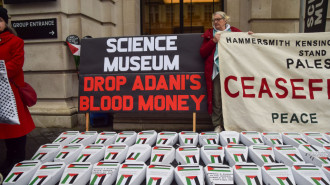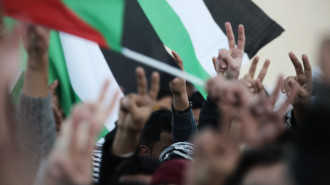
Jordan's street art movement colours its urban landscapes

Jordan’s urban landscapes have become the canvas for a growing number of street artists – the cities’ sand-coloured backdrops are now speckled with colour.
To the onlooker's gaze, the wall-high street murals beautify the streets and entertain passers-by. But when one looks deeper, nearly every mural holds another meaning; reflecting the gaps between tradition and modernity in Arab society; of femininity and gender norms; of a generation of youth challenging traditional norms embedded within a conservative society.
In the last decade, the street art scene has boomed in Jordan. The artwork now spreads out from the country’s capital Amman, decorating the Kingdom from the southernmost city, Aqaba, to Irbid in the north.
"The boom of Jordan’s street art movement has coincided with an emerging hip-hop culture – street art is a part of graffiti, one of the five elements of hip-hop"
In Madaba, about 30 kilometres south of Amman, three portraits of women are painted on three abandoned shop doors. The first shed a tear, the second has been abused, and the third holds inside her tears before they pour.
“I love these three women,” said the artist, Nada al-Qarra. The 25-year-old artist is one of the dozens of street artists active in Jordan’s graffiti scene, many of whom are women, rare in the traditionally male-dominated sphere.
Nada said she was drawn to street art about seven years ago, but at the time the streets of Madaba, her hometown, were devoid of artwork.
The young artist became one of the first to paint the city, more conservative than parts of Amman. She said that in the beginning, those around her were sceptical of her artwork, mostly portraits of women that depict the female emotions “not always comfortably shared.”
But Nada continued her artwork, undeterred by the scepticism. “I like the idea of painting on the streets to force the public to get into the idea I want to share,” she stated.
North of Madaba in Irbid a nearly 20-metre-tall woman grips an orange rose, while doves encircle her shoulders. The artist, Laila Ajjawi, 32, said the woman is married, and “wants peace in the house”, the mural was done to spotlight the increase of gender-based violence during the pandemic.
Laila grew up in Irbid’s Palestinian refugee camp, one of the ten camps for Palestinian refugees in the country. “Growing up in the camp, there was graffiti all the time,” she said, her passion for street art influenced by the graffiti she was surrounded by in her childhood.
Her first street art mural was during the 2014 war in Gaza. “I felt that this wall could only reflect my anger,” she said. Since then she has used her art to raise awareness for the Palestinian cause, as well as women’s rights.
“Street art is my personal interest and my mission,” Laila said, “It has given me another dimension to express.”
Hip-hop hub
The boom of Jordan’s street art movement has coincided with emerging hip-hop culture – street art is a part of graffiti, one of the five elements of hip-hop. The other four elements include breakdancing, rap, DJing, and beatboxing, said Alaeddin Rahmeh, 33, a graffiti “writer” and break-dancer who has helped lead Jordan’s hip-hop scene over the past decade.
When Alaeddin first started painting he said he was one of three active street artists and dancers in Amman. But now, he said, hip-hop music has entered the mainstream and the street art scene “is booming.”
He spoke to the multiple hip-hop and street art festivals in Jordan, which have helped local talents flourish. Since 2012, the country has hosted the Baladk festival for street art, which has brought together artists from Jordan, Europe and Central America, and has contributed to nearly 35 works of art throughout the streets of Amman.
|
The Hashmi Al-Shamali neighbourhood in East Amman has been transformed into Jordan’s first open-air street museum. Once military housing, the neighbourhood's three-story cement buildings now showcase nearly 27 murals, said Alaeddin, much of the artwork painted during the Baladk festivals by both local and foreign artists.
However, while the festivals like Baladk have helped the scene flourish, some of Jordan’s artists feel there is often a prioritisation of hip-hop artists from outside Jordan.
Laila, the street artist from Irbid, said she “welcomes every kind of art”, but the space given to foreign artists is sometimes larger and overshadows the work of local artists, Alaeddin echoing her concerns.
The talent coming from local artists is “shocking”, said Alaeddin; the unique content emerging from Jordan’s hip-hop scene is a blend of “traditional” and “modern”, as the local culture has fused with hip-hop movements from abroad. For instance, noted Alaeddin, some rap tunes are a blend of more mainstream hip-hop beats with traditional Arabic melodies.
“In 10 years, Jordan will become a hub for street art and hip-hop,” Alaeddin said, “People from everywhere will start coming here to see and learn about the stories and the amazing artists.”
Women's involvement
On the metres-tall mural Irbid, the woman is draped in a wool hijab. She has wavy, dark hair and wrinkles, Laila noting she wanted the woman to reflect many in the country. She added, “I am proud and happy to represent women that look like me, which represent our culture here.”
Laila is a strong advocate for female education, part of her experience seeing some of her female friends forced to leave school, or forbidden to attend university, she said. She aims to spread support for women’s education in her artwork: “You are putting in the street something that will be reflected within people all around,” she said, “I wanted to do something, leave a good thing behind.”
Nadda, the street artist from Madaba, frequently leads workshops for youth in her city, noting that she has seen great interest from particularly females. “As females, we want to do something different. We want to let people know that we are becoming different. That we are changing from what our parents were, we’re not gonna live in the same,” she said.
She also noted that she has seen the interest in street art growing in recent years. “When I first started, it [street art] was such an odd thing,” she said, “But now I see young people trying to do more.
“It amazes me how it [street art movement] started and how it is right now,” she said, “I can’t wait to see Jordan in 10 years, it will be full of art.”
Hanna Davis is a freelance journalist reporting on politics, foreign policy, and humanitarian affairs.
Follow her on Twitter: @hannadavis341



